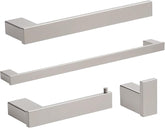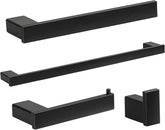Wall-Mounted Bathroom Faucets: Space-Saving Solutions for European Bathrooms
Walk into most modern European bathrooms—whether a tiny Paris apartment bath or a sleek Berlin loft—and you’ll likely spot a common feature: wall-mounted faucets. Unlike traditional countertop faucets that take up sink space, these fixtures mount directly to the wall, freeing up room for toiletries, soap dishes, or just a cleaner look. For European homes, where bathroom square footage is often at a premium, this space-saving design isn’t just a trend—it’s a practical solution that balances style and functionality. Below’s what you need to know to choose, install, and love wall-mounted faucets in your European bathroom.
Why Wall-Mounted Faucets Are a Hit in European Bathrooms
European bathrooms prioritize efficiency and minimalism, and wall-mounted faucets check both boxes. Here’s why they’re so popular:
- Maximize counter space: Small European bathrooms (many under 5 square meters) can’t waste space on countertop faucets. Wall-mounted designs leave sinks clear for toothbrushes, cups, or even a small plant.
- Easy to clean: No faucet base on the counter means no hard-to-reach gaps where grime builds up—just wipe the sink and wall clean, a big plus for busy households.
- Elevate style: They create a “floating” look that makes bathrooms feel airier. This works with every European aesthetic, from Scandinavian minimalism to Italian modern design.
- Flexible height: You can install them at the perfect height for your sink (taller for vessel sinks, lower for undermount ones), which traditional faucets often don’t allow.
How to Choose the Right Wall-Mounted Faucet for European Bathrooms
Not all wall-mounted faucets work for European spaces—focus on these three key factors:
1. Match It to Your Sink Type
European bathrooms use specific sink styles, so pick a faucet that fits:
- Undermount sinks: Go for low-profile wall-mounted faucets (spout height 15–20cm) to avoid splashing.
- Vessel sinks: Choose taller spouts (25–30cm) to reach over the sink’s edge—this is common in small UK or Dutch bathrooms.
- Wall-hung sinks: Opt for compact, single-handle models (they take up less wall space) to keep the look streamlined.
2. Check for European Plumbing Compatibility
European plumbing standards differ from other regions—don’t skip these checks:
- Pressure rating: Ensure the faucet works with European water pressure (typically 1–3 bar). Most reputable brands (like Grohe, Hansgrohe) label this clearly.
- Connection size: European pipes use 1/2-inch connections—avoid faucets made for 3/8-inch American pipes, which will need adapters.
- Certifications: Look for CE or WRAS certification to confirm it meets European safety and water efficiency standards.
3. Pick a Style That Fits Your Bathroom
Wall-mounted faucets come in designs that match European decor trends:
- Scandinavian: Matte black or brushed nickel, single-handle models (clean lines, no extra details).
- Mediterranean: Polished brass or chrome, with curved spouts (adds warmth to tile-heavy bathrooms).
- Industrial: Stainless steel, lever handles (great for Berlin or Brussels loft bathrooms).
Key Installation Tips (Critical for European Bathrooms)
Wall-mounted faucets need in-wall rough-in (hiding pipes inside the wall)—here’s what European homeowners should know:
- Hire a pro if you’re renovating: If your bathroom walls are already tiled, you’ll need a plumber to cut into the wall and install the rough-in valve (this avoids damaging tiles).
- Plan during new builds: If you’re building a bathroom, have the plumber install the rough-in valve before tiling—this saves time and money.
- Consider wall depth: European apartment walls are often thin (10–15cm). Choose compact rough-in valves (like those from Geberit) to fit without sticking out.
- Test before finishing: Turn on the water to check for leaks before sealing the wall—fixing leaks later means tearing down tiles.
Quick Maintenance to Keep Them Working Well
Wall-mounted faucets are low-maintenance, but follow these steps to keep them in shape:
- Clean the spout weekly: Wipe it with a damp cloth to remove hard water stains (common in hard-water regions like parts of Germany or France).
- Check for wall leaks: Every few months, look behind the faucet for water spots—this could mean a loose in-wall connection.
- Lubricate handles annually: Use silicone lubricant on handle valves to keep them turning smoothly (avoid oil-based lubricants, which attract dust).
For European bathrooms, wall-mounted faucets aren’t just a stylish choice—they’re a smart way to make small spaces feel bigger and more functional. By choosing the right style, ensuring compatibility, and getting proper installation, you’ll have a fixture that looks great and works well for years.





